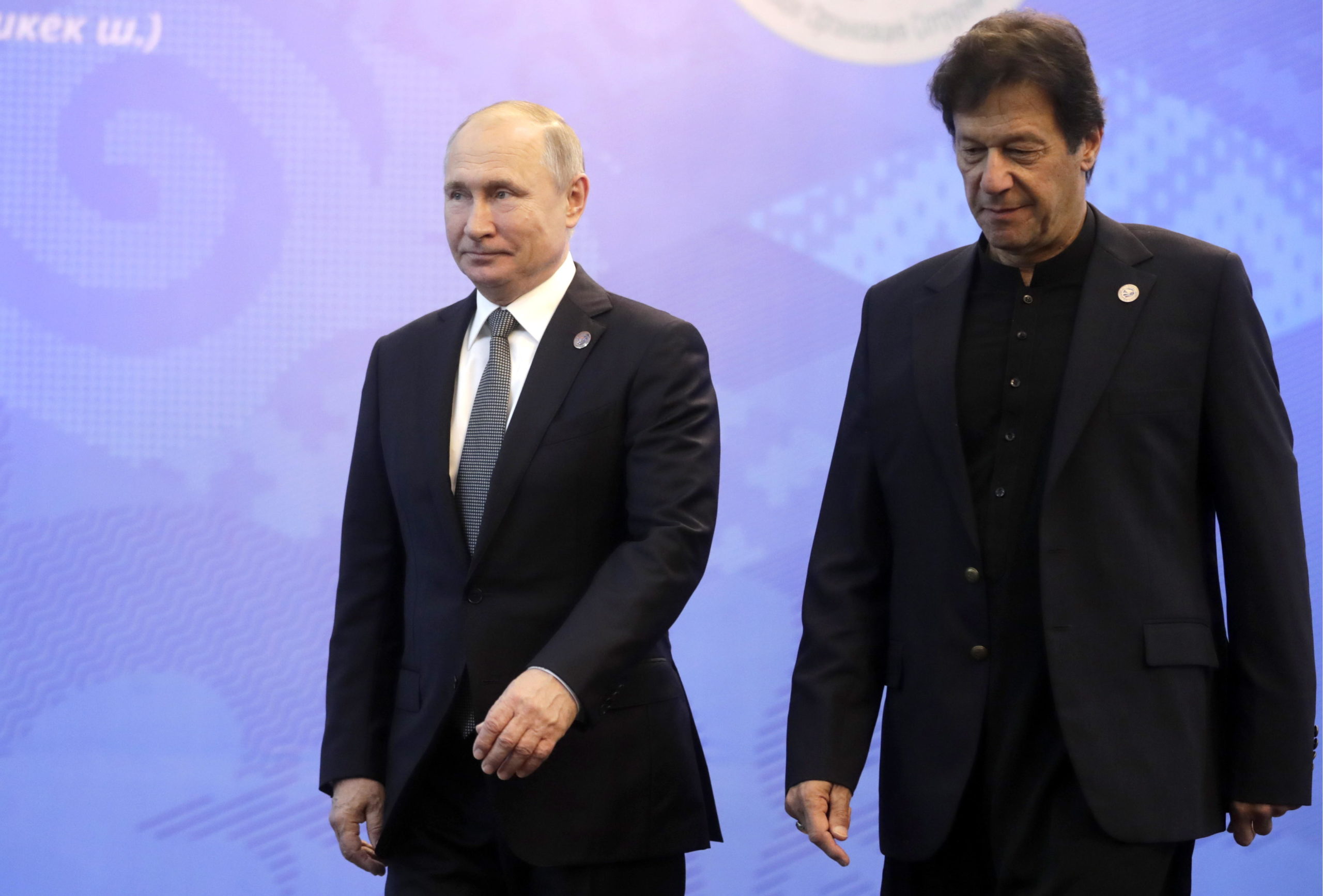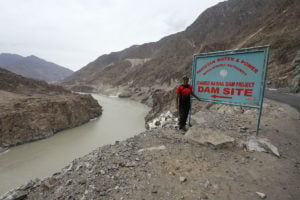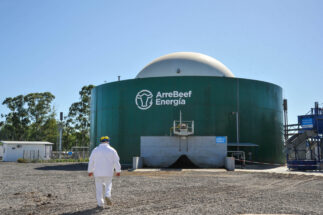Pakistani Prime Minister Imran Khan’s arrival in Russia has been dramatically overshadowed by Russian forces entering Ukraine. The geostrategic consequences for Pakistan of the two-day visit to Moscow, the first by a Pakistani premier in 23 years, are likely to be analysed through the hardening stances of the many actors in the current conflict. The long-term consequences, though, have almost everything to do with the future of natural gas.
Khan’s visit comes just after Germany, the largest consumer of Russian gas, halted certification of a new Nord Stream 2 pipeline. Russia recently agreed upon a 30-year contract to supply gas to China, coinciding with President Vladimir Putin’s visit to the Beijing Winter Olympics. As Russia seeks new clients for its construction technology and fossil fuels, and with Pakistan desperate for a secure and cheap supply of natural gas, the visit could lay the foundations for Russia building a pipeline to transport natural gas from Karachi to Lahore.
Russia is the world’s second biggest producer of natural gas. Meanwhile Pakistan, with declining gas reserves, faces a major supply problem as gas still makes up a substantial part of its energy mix.
Pakistan’s energy minister, Hammad Azhar, speaking to The Third Pole, said the trip is only an “opportunity to learn the technology” of laying a gas pipeline from the Russians, whom he says are the best in the business. Pakistan wants to construct a 1,100-kilometre gas pipeline, known as the Pakistan Stream Gas Pipeline Project, from Port Qasim in Karachi, in Sindh, to Kasur in Punjab. The USD 2.5 billion project is tentatively slated to begin next year, though an initial agreement was first signed in 2015 and a second in 2021.
“We don’t have the expertise of the scale and size that is needed for this project,” Azhar told The Third Pole over the phone from Islamabad. “The project will remain majority-owned [74%] by Pakistan to begin with, so it could be a win-win,” he said.
Former prime minister Shahid Khaqan Abbasi, who envisioned the project in 2013 when he was minister for petroleum and natural resources, held a similar view. The project had remained dormant due to various “financial bottlenecks”, said Abbasi.
“My fear is that this government will face the same hurdle we did and will be unable to justify the build-operate-transfer price structure of how much to pay the Russians for the amount of gas that flows through the new pipeline,” warned Abbasi, referring to a model under which large projects are financed and developed through public-private partnerships.
Increasing demand, decreasing supply
Pakistan’s production of natural gas peaked in 2009, according to the International Energy Agency, but gas has continued to increase as a percentage of total energy supply steadily since then. This has led to a slow-moving crisis as Pakistan scrambles to make up the difference.
Major cities increasingly face prolonged gas outages, hitting both residents and businesses hard. In December last year, the government said the country will soon run out of local gas, therefore increasing reliance on expensive imported gas.
As a former energy minister, Abbasi had seen importing liquefied natural gas (LNG) as a quick solution to the energy crisis driven by a fall in domestic gas production. “We tried to bring in gas through a pipeline from Iran but that came under US sanctions and another one from Turkmenistan, but even that could not materialise, mainly due to security reasons as it had to pass through Afghanistan,” he told The Third Pole.
“We need this pipeline because we need more LNG,” said the current energy minister, Azhar. “It’s a project that all my predecessors struggled to set up. While the present government will not rush into it, it will also not shy away from being decisive.”
The former prime minister, Abbasi, is no longer sure if Pakistan needs the gas pipeline at all. “Local gas has depleted so much and the existing terminals are working at 60% capacity. The present network of pipelines is enough to carry local as well as imported gas for now,” he said.
Weak infrastructure, interrupted supplies
The question is really whether Pakistan will continue to invest in gas infrastructure. This is why the Russian trip, and a possible deal, is so important to Pakistan’s energy future.
“Today, 60% of LNG is used by the three power plants, the remaining 40% by the industrial sector,” said Azhar. Due to the depletion of local gas, a “host of new customers” – including fertiliser and cement factories – began to rely on LNG.
Presently, 4.5 million tonnes of LNG are imported every year from Qatar Energy, with which Pakistan has long term contracts. The country buys more from Italian oil and gas giant ENI and commodities trader Gunvor. This is still not enough for Pakistan. In the last couple of years, said Azhar, while gas reserves are declining 9% per annum, more and more import industries turned to LNG to continue running their factories.
Did you know…
Pakistan is predicted to dominate LNG growth in emerging Asia along with Bangladesh and Thailand over the next five years. According to a report in Bloomberg, the three countries will nearly double LNG imports over 2021-25.
The demand is there, but not the infrastructure to cater to it.
Pakistan has two LNG terminals: Engro Elengy Terminal Limited (EETL) and PGP Consortium Limited (PGPCL), at Port Qasim, built in 2015 and 2017 respectively. With elections nearing in 2023, the government’s desperation to end gas shortages can be gauged from the fact that the prime minister ordered the energy ministry to build a third terminal by the end of 2023.
But Pakistan’s problem does not end there. This winter, after two long-term contract suppliers – ENI and Guvnor – defaulted on deliveries, Pakistan had to buy at a whopping USD 30.6/mmbtu from Qatar Energy to meet demand.
“We will continue to face an immense shortage of gas due to domestic depletion so we have to look at LNG for relief. It is, after all, the single largest primary fuel for Pakistan,” said Khurram Hussain, a leading business and economy journalist, “and that is why the pipeline is important” for the country.
Forgetting a green energy future
In its race to overcome gas shortages, however, the government seems to have forgotten its promises of a cleaner, greener way of running the country.
Vaqar Zakaria, head of environmental consultancy firm Hagler Bailley Pakistan, said that while in the past it made sense to invest in LNG, it is far too expensive today. LNG used to be the “cheapest and cleanest of fossil fuels”, he said, and Pakistan had a ready-to-use gas infrastructure in place. But, he added, Pakistan failed to realise that with coal and oil getting a “bad rap”, the world would look towards gas to replace the comparatively dirtier fuels, and that with an increase in global demand, the price of gas would naturally escalate. It is time, he said, to tap into the country’s “abundant wind and solar potential” and not rely on imported gas for power generation.
In the short term, liquefied natural gas may actually prove to be more harmful than coalHaneea Isaad, the Institute for Energy Economics and Financial Analysis
It is also likely to be much cheaper to switch to solar and wind. Haneea Isaad, a research associate at the Institute for Energy Economics and Financial Analysis, calculated that a floating offshore LNG terminal would cost anywhere between USD 400–500 million. “I am not factoring in the operational expenses and imported fuel costs,” she said, speaking to The Third Pole.
In comparison, at USD 600,000 per megawatt (MW), installing a 1,000 MW solar plant would cost almost the same as a single LNG terminal, she said. On top of this, the life cycle greenhouse gas emissions from wind and solar are a mere fraction of those associated with LNG. “Not to mention the added advantage of being domestically available and having negligible marginal costs,” said Isaad.
Claims that LNG is cleaner than coal should be treated with caution, according to Issad. “In the short term, it may actually prove to be more harmful than coal if we look at things from a life cycle perspective,” she said, adding that from the well to the burning of actual fuel at power plants, the entire LNG supply chain leads to either carbon dioxide or methane emissions. “Over a 20-year period, methane can be 80 times more potent than carbon dioxide,” she said.
For resource-stretched Pakistan, it may still not be too late to take the money out of LNG and invest in climate-friendly renewables.









